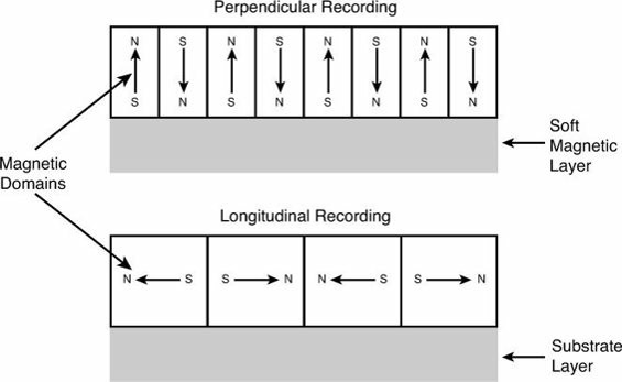Hardware Reference
In-Depth Information
Figure 8.14. Perpendicular versus longitudinal recording.
Conventional magnetic recording places magnetic domains longitudinally, meaning the domains lie
end to end on the disk. This not only limits the density of the domains, but also helps to enable the
superparamagnetic effect. Long ago it was realized that if one could place the domains perpendicular
to the media (also called a
vertical recording
), the density could be increased, as could the
resistance of the domains to the superparamagnetic effect. Although the concept was easy to
understand, actually implementing it has been difficult.
Unlike GMR heads and AFC media—both of which can be added relatively easily to existing drive
technologies—perpendicular recording requires entirely new read/write head designs.
Figure 8.14
shows the difference between perpendicular and longitudinal recording. You can get at least twice the
number of magnetic domains in the same space with perpendicular recording.
Using perpendicular recording, the heads are designed to write deep into the media, using a thicker
soft magnetic underlayer as a return path for the magnetic field. This enables the domains to be
vertically aligned, and thus placed much more closely together without unwanted interaction
problems.
Perpendicular recording was first demonstrated in the late nineteenth century by Danish scientist
Valdemar Poulsen, who was also the first person to demonstrate that sound could be recorded
magnetically. There weren't many advances in perpendicular recording until 1976 when Dr. Shun-
ichi Iwasaki (president of the Tohoku Institute of Technology in Japan) verified the distinct density
advantages in perpendicular recording. Then in 1978, Dr. T. Fujiwara began an intensive research
and development program at the Toshiba Corporation that eventually resulted in the perfection of
floppy disk media optimized for perpendicular recording and the first commercially available
magnetic storage devices using the technique.
The first use of perpendicular recording in PCs was with the 3 1/2-inch, 2.88MB ED (extra-high
density) floppy format developed by Toshiba and officially announced in 1987, with the ED drives
and disks finally reaching production in 1989. IBM officially adopted these drives in its PS/2 systems
in 1991, and a number of manufacturers began making them for IBM and other PC manufacturers,
including Toshiba, Mitsubishi, Sony, and Panasonic. Because a 2.88MB ED drive can fully read and


